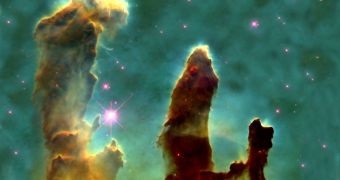It is largely speculated throughout the astrophysical community that the first stars might have been created out of dark matter, albeit while we mostly know nothing about dark matter and dark energy, what it is made of and its properties, now a theoretical physicist at the University of Michigan, Katherine Freese, proposes a model according to which dark matter that formed the first stars could have been converted into ordinary matter before stars were able to turn into main sequence stars.
Freese writes that, about 100 to 200 million years after the Big Bang event, the universe could have been populated mostly by dark matter and dark energy. She argues that, similarly to regular matter which has a counterpart in the form of anti-matter, dark matter might also have an anti-dark matter component which, through annihilation processes, could have provided with the energy required to initiate nuclear fusion reactions in some of the first stars.
An annihilation process between matter and anti-matter results in the conversion of the energy contained by two particles into another form of energy, with the loss of the identity of the original particles that contributed to the decay. Freese says that the same process should in fact be available for dark matter as well, thus, when dark matter particles annihilate with their opposite particles, their energy is converted into neutrinos and one third of that energy goes into creating electrons and positron particles while one third is converted into photon particles.
The material that goes into the creation of a star must be able to cool before it collapses into a dense object, in order to start nuclear fusion reactions. However, the first stars, although cool enough, could not start a nuclear fusion process, meaning something else must take place before this happened. As dark matter stars slowly shifted towards the nuclear fusion phase, the dark matter annihilation processes produced enough energy so that it would prevent regular matter from collapsing into a main sequence star.
Nonetheless, as with the hydrogen in regular stars observed in the universe today, dark matter and its counterpart would have depleted at one point in time, allowing the star to finally cool enough to collapse and initiate nuclear fusion reactions, turning hydrogen gas into helium and even heavier elements such as carbon, nitrogen, oxygen and the other metals in the periodic table. In the final stages of the star's life, being unable to sustain the fusion of the heavier elements, the star becomes unstable and explodes into a supernova so that it can spread the newly created elements through interstellar space to be used by the next generation of stars.
Our Sun is actually a Population I star, while some of the first stars to appear in the universe were Population III. Freese believes that Population III stars were not driven by nuclear fusion reactions at the beginning, but they shifted towards nuclear fusion as the dark matter at their cores depleted through annihilation processes. Such phase was only available for the first stars!
We may be looking long and hard for evidence of dark matter existence and its properties, but the theory proposed by Freese could in fact be tested as soon as 2013, when NASA has scheduled to launch the James Webb Space Telescope, to look for 'dark stars'. Freese says these stars would be much cooler than the nuclear fusion reaction powered stars today, but still hot enough to prevent the nuclear fusion. Until then, however, she argues that, by speculating on the properties of 'dark stars', astrophysicists may be able to calculate the stellar evolution phase and the timing of the apparition of the first black holes in the universe, which could also affect the timing of our own galaxy development.

 14 DAY TRIAL //
14 DAY TRIAL //